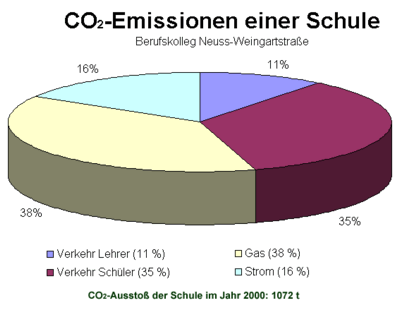 CO2 balance for the school
CO2 balance for the school
Target group
Students from 14 to 18 years .
Learning aims
Each school contributes to the release of carbon dioxide and therefore to climate change for example with their energy usage and the daily way to school of the pupils and teachers. A CO2-balance should raise awareness amongst the pupils and teachers.
The CO2 balance is also suitable as a management instrument. It can additionally serve to estimate the effects of future environmental measures and therefore select the most suitable measures. If the balance is continued over several years, the results of the environmental measures can be documented.
Short description
Initially it is determined which areas of school operation should be included in the balance and what period of time they should be recorded for.
Information is collected for these areas. For example from the energy bills you can see how many kWh of heat energy have been used in the past year; the fuel used in the school is usually known. The compilation of information about daily ways to school requires more effort: hereby a spot check of pupils and/or teachers is carried out and these details are added up for the whole school.
The data compiled in this way – e.g. X kWh heat energy from natural gas or Y kilometres per person with the bus – can now be converted into kg of released CO2 using overall factors. Finally the CO2 emissions will be added up for all areas involved.
Building on the basis of this data, the school can now estimate for example how they can improve their CO2 balance, when they obtain electricity from renewable energy sources in future or control the room temperatures better in the future and therefore save a certain percentage of heating energy.
Reflection
A dozen schools in Germany have developed a scholastic environmental management system since the end of the 1990’s. Some of them have also calculated their CO2 balance. You can find corresponding work materials for example here at the online information service www.umweltschulen.de.
The vocational college in Neuss Weingartstraße was able to reduce the CO2 emissions per head (pupils, teachers, employees) from 787.4 kg in 1998 to 535.5 kg in 2004.
More information
(Sorry: only in German language):
- Background information on energy, atmosphere, climate protection
- Environmental management in the Vocational College in Neuss Weingartstraße (including CO2 balance)
- A lesson on CO2 balance


